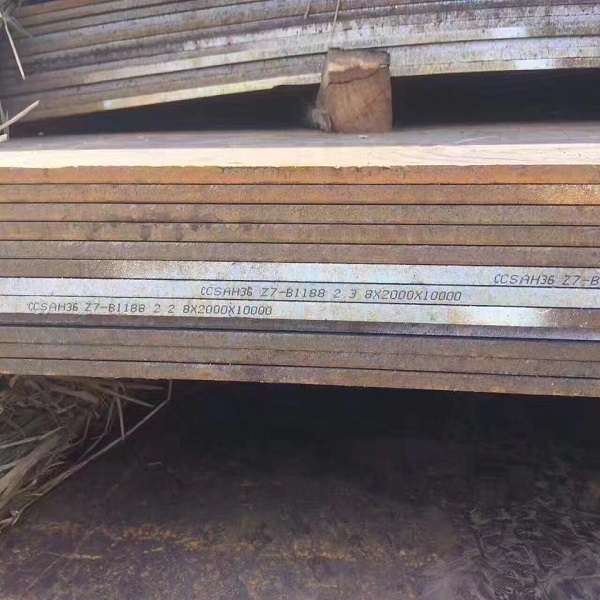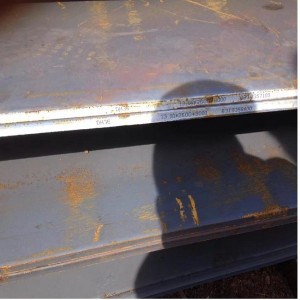China BV Marine Grade AH36 ccsb ah32 dh36 eh36 Shipbuilding steel plates Manufacturer and Supplier | Ruiyi
BV AH36 Shipbuilding steel plates are suitable for container and bulk cargo vessels as well as cruise ships, ferries and yachts.
AH36 steel plate is the grade of high-strength ship plate, and high-strength ship plate also has AH32.DH32, DH36, EH36 and so on. According to its different classification society certification, it can also be divided into LR, ABS, NK, DNV, CCS and so on. AH36 steel plate is mainly used to produce components with relatively large hull stress. The steel producers that can produce AH36 include Baosteel, Wuhan Iron and Steel, Shougang, Hunan Iron and Steel, Anshan Iron and Steel, Nangang, Xinyu and so on. The main factory form is the factory flat plate, with superior mechanical properties and precise dimensions. Common widths are 1800/2000/2200/2500MM.
Shipbuild plate refers to the hot-rolled steel plate used to manufacture the hull structure produced in accordance with the requirements of the classification society’s construction rules. The general-strength structural steels in the standards of China Classification Society are divided into four quality grades: A, B, D, and E (namely CCSA, CCSB, CCSD, CCSE); the high-strength structural steels in the standards of China Classification Society are three Intensity levels, four quality levels.
1. Commonly used ship plate steel models
1. AH32, AH36, DH32, DH36, etc.
These types of steel are code-approved ship plate steels and are commonly used in the shipbuilding industry. They are excellent in wear resistance, impact resistance and corrosion resistance, and are widely used in shipbuilding.
2. D36, E36, F36
These types of steels are also code-approved ship plate steels, but have higher strength and toughness than the AH series steels, making them suitable for marine engineering, ship structures and offshore installations.
3. HSLA series steel
HSLA is high-strength low-alloy steel, which has high strength, high plasticity and good welding performance. Commonly used HSLA series steels include: AH40, DH40, EH40 and FH40, etc. These steels are widely used in shipbuilding, marine engineering, port facilities and coastline construction due to their good corrosion resistance and long service life.
Second, the characteristics of ship plate steel
Ship plate steel needs to meet the following requirements:
1. Abrasion resistance: In seawater and humid environment, ship plate steel needs to have better wear resistance to increase the life of the hull.
2. Corrosion resistance: Due to the high content of salt, moisture and oxygen in seawater, ship plate steel needs to have excellent corrosion resistance to avoid rust and corrosion.
3. High plasticity: Ship plate steel needs to have good plasticity to facilitate steel processing and forming to meet different hull shape and size requirements.
4. Good welding performance: In the process of connecting and repairing ship plate steel, good welding performance is required to ensure the connection strength and the overall performance of the hull.
Ship plate is an important component in shipbuilding, and the selection of steel materials is very important. Commonly used ship plate steel models include AH32, AH36, DH32, DH36, D36, E36, F36 and HSLA series steel, etc. These steels have the characteristics of good wear resistance, good corrosion resistance, high plasticity and good welding performance, and are suitable for different fields such as shipbuilding, marine engineering and port facility construction.
BV AH36 Shipbuilding Steel Chemical Composition:
|
Grade |
C % |
Si % |
Mn % |
P % |
S % |
V % |
AL % |
Cr % |
|
BV Grade AH36 |
0.180 |
0.1-0.5 |
0.90-1.6 |
0.035 |
0.035 |
0.05-0.10 |
0.015 |
0.200 |
|
Cu % |
Mo % |
Nb % |
Ni % |
Ti % |
|
|
|
|
|
0.350 |
0.080 |
0.02-0.05 |
0.400 |
0.020 |
|
|
|
BV AH36 Grade Ship Steel Mechanical Properties:
| Grade |
Thickness(mm) |
MinYield(Mpa) |
Tensile(Mpa) |
Elongation (%) |
Min Impact Energy |
|
|
BV Grade AH36 |
8mm-50mm |
Min 355Mpa |
490-620Mpa |
21% |
-0 |
34J |
|
51mm-70mm |
Min 355Mpa |
490-620Mpa |
21% |
-0 |
41J |
|
|
71mm-100mm |
Min 355Mpa |
490-620Mpa |
21% |
-0 |
50J |
|
| The min impact energy is longitudinal energy
|
||||||
| Equivalent Steel Grade of BV / AH36 | |||||||
| DNV | GL | LR | BV | CCS | NK | KR | RINA |
| NV A36 | GL-A36 | LR/AH36 | BV/AH36 | CCS/A36 | K A36 | R A36 | RI/A36 |
BV AH36 steel plate, BV AH36 steel sheet,BV Grade AH36 shipbuilding steel price,BV Grade AH36 steel supplier and manufacturer.
BV AH36 shipbuilding Steel Description:
All BV steels are standard carbon steels. All of these steels have been engineered to be optimal long-lived shipbuilding steels.As with other grades of steel, they have a specific gravity of 7.8.Higher-strength BV shipbuilding steel comes in six grades of two strengths, The BV AH36 grades have yield strength of 51,000 psi (355 MPa), and ultimate tensile strength of 71,000 – 90,000 psi (490-620 MPa).
BV AH36 Shipbuilding Steel Application:
BV AH36 Shipbuilding steel plates are suitable for container and bulk cargo vessels as well as cruise ships, ferries and yachts.
BV AH36 Steel Grade Specification:
Thickness: 4mm to 260mm,
Width: 1200mm to 4000mm
Length: 3000mm to 18000mm.
BV AH36 Ship Steel Delivery Conditions:
BV AH36 Delivery Condition: AR(As hot rolled only), TMCP, Q+T(Quenching+Tempering), N(Normalizing),CR( Control rolled only)
BV AH36 Steel Plate Additional Service:
Hot rolled(HR), control rolled(CR) Thermo Mechanical Control Process(TMCP), Normalized , Q&T, impact test, Z15,Z25,Z35.
The main difference between marine steel plates and ordinary steel plates lies in their use occasions and technical requirements.
First of all, marine steel plates are generally used in the construction and maintenance of boats. They need to have good corrosion resistance, compression resistance and low temperature toughness to ensure that ships can withstand extreme forces and environmental tests such as high pressure and large waves in harsh marine environments. Ordinary steel plates are mainly used in construction and engineering fields, and do not need to withstand the special requirements of the marine environment.
Secondly, the technical requirements for marine steel plates are more stringent than ordinary steel plates. For example, marine steel plates need to have high welding performance and low temperature toughness, and need to go through a series of production processes such as complex steel plate control, heating, rolling and cooling to ensure that their quality and performance meet the standards for ship construction and use. The production process of ordinary steel plates is relatively simple, and does not require too much processing and control.
To sum up, although both marine steel plates and ordinary steel plates are steel materials, there are obvious differences in their use occasions and production processes, and they need to be selected and purchased according to specific needs.













